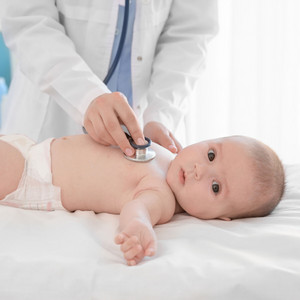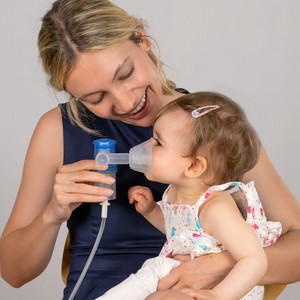
It can be challenging for parents if their little one has a cough and a cold. As the airways of infants are not yet fully developed, they often find it difficult to cough up the phlegm (also called mucus). In the first few months of life they also breathe mainly through their nose, which makes a cold especially difficult.
But what can you do if the infant has a cold and is coughing? Here are some tips on how to gently and effectively help your little darling through the infection.
The following can help if your infant has a cold and a cough: Rest, drink plenty, fresh air, inhalation therapy with isotonic or hypertonic saline solution using an inhalation device with a suitable baby mask, such as the PARI BOY Junior. If they have a fever or are short of breath, it is important that the child sees their paediatrician.
“Every infection takes rest and time to recover. That is the most important rule!”, emphasises the paediatrician Dr Markus Praun. Therefore, allow your child to get plenty of rest and sleep.
You should still take your baby on a walk in the fresh air as long as they do not have a fever: fresh air stimulates the circulation and boosts the metabolism and this helps recovery. Regularly opening your windows to let the fresh air in is also recommended.

Sufficient fluids are essential to keep the mucous membranes moist and to support the healing process. You should regularly breastfeed your baby or given them a bottle of formula. From about seven months of age, your baby can also have water (not carbonated) or unsweetened herbal tea. This keeps your baby’s little body properly hydrated when they have a cold.
Wash your hands before you touch your little one, especially if you have been out and about in public spaces. Consistent hand hygiene prevents your child’s immune system being exposed to new pathogens when they are already ill. Also wash your hands after cleaning your infant’s snotty nose and ensure that they do not play with dirty tissues. If that happens, immediately wash your child’s hands.

Inhalation therapy with isotonic saline solution (0.9%) with an inhalation device is a tried and tested method to moisten the airways and to release mucus. Paediatrician Dr Markus Praun recommends: “Especially with airway infections it very important to take care of the airways with inhalation therapy. Having well-moistened mucous membranes in the airways improves sleep quality and supports healing.”
To do this, use an inhalation device such as the PARI BOY Junior. This includes everything you need for inhalation therapy with your baby: two snug fitting masks depending on age and an angled piece so that your baby can even have their inhalation therapy lying on your arm. Even if the inhalation therapy is a little strange to start with, it is worth the effort. In the blog you can see tips from a respiratory physiotherapist on successful inhalation therapy with infants.
If the mucus is especially thick, inhalation with a 3% hypertonic saline solution provides excellent support. Hypertonic saline solution such as MucoClear 3% is suitable for infants and liquifies the mucus effectively so that it can flow out of the nose more easily. Mucus in the bronchial tubes is also easier to shift when you inhale hypertonic saline solution.
Especially if your infant is struggling with a cough and a mucus build-up in the bronchial tubes, it is helpful to gently massage their chest and to gently run your fingertips over the spaces between the ribs. That stimulates circulation, which has a positive effect on breathing. Massages also tend to be very relaxing.
If your baby has other symptoms aside from a cough and a cold, such as fever over 38.5°C, vomiting, stomach ache or behavioural changes, they should see a doctor immediately.
Note: The information in this blog post is not a treatment recommendation. The needs of patients vary greatly from person to person. The treatment approaches presented should be viewed only as examples. PARI recommends that patients always consult with their physician or physiotherapist first.
An article written by the PARI BLOG editorial team.
© 2025 PARI GmbH Spezialisten für effektive Inhalation